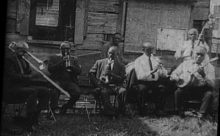The Restoration of the Cradle is Rocking
I was the photographer on the film, which was shot around 1965, or 66 and finished in 1967. The film was made for a new Kennedy administration initiative under the direction of George Stevens Jr. The program was a precursor to the American Film Institute Grants and was set up to encourage young filmmakers. These films were for the United States Information Agency, which had libraries around the world to promote and explain American culture.
Frank DeCola was a composer and “The Cradle is Rocking” exhibits his keen sense of timing and music. His regular paying job was with the NFL where he cut football movies. We shot the film with a 35mm Arri using B&W negative film. The camera was big and heavy. Nigel Noble recorded sound on a nagra but the camera and recorder did not run in sync. There is only one “sync scene” in the film where Kid Sheik Colar teaches a young man (from Sweden) how to play the trumpet. I recall that we used a sound blimp for the noisy Arri camera and may have had an umbilical cord between the camera and recorder so sync could be maintained. The first person narrative was done by an actor from a script that Frank DeCola based on interviews with George Colar (Kid Sheik).
After this film Frank and I teamed up on a project about the Shakers (a religious community), but unfortunately he died of a brain tumor in 1972, before that film was completed.
Frank had given me a 16mm reduction print of the The Cradle is Rocking. I projected this print in many times in the 1970s and 1980s, and stored it in a damp basement in my house. When I decided to put it on Folkstreams.net, I sent my print to Colorlab for a transfer. The transfer showed what terrible shape my print was in, and I decided to try to find a better one. I streamed my print on youtube with a plea for help finding a better one. I also looked in the National Archives, the Library of Congress, and put out inquires on the Association of Moving Image Archivists list serve.
I didn’t have much success. By law, USIA films could not be shown in the USA. So most prints would have been 16mm prints in USIA Libraries overseas. These no longer exist. But I located one 16mm print in the archives of Australia (probably left over from the USIA library there) and a VHS copy of the film made from a Canadian video copy.
Frank DeCola was a few years older than me so he was born in the 1930s. His wife’s name was Vera and I paid for a search on the Internet for Vera DeCola and found a Vera DeCola near Boston. I called the number but it had been disconnected. I feared that she had died.
Frank and Vera had two children and from my Internet search, I was reminded that the daughter’s name was Valery DeCola. I search Facebook and found a Valery DeCola who was about the age that Frank’s daughter would have been. I sent a message to her on Facebook, and she replied. Valery (and her mother who was still living but in Italy) had no prints of The Cradle is Rocking. Valery thought that her cousin, Frank’s nephew Phil DeCola might have a print.
We contacted him and Phil did have a print, which he hand delivered to Colorlab in Rockville, MD for transfer to digital beta. The print and the dbeta were deposited in the Folkstreams collection in the Southern Folklife Collection at the University of North Carolina in Chapel Hill, where we keep the Folkstreams archive. This was all done by email and postal mail, so I never saw the print myself and assumed that it was a 16mm print like mine.
Colorlab prepared a bid on the restoration work based on 16mm footage, but when the print arrived for cleaning, I got a call that this print was a 35mm print and that the estimate would need to be revised.
We were very lucky. The print is probably the only 35mm print in existence, and it was in perfect shape. I doubt if it had ever been projected. We now have that print, a dupe negative from the print, an answer print (proof release print) and a regular release print. So we have three positive copies of the 12 minute film and a negative copy with a negative optical track for printing. All in 35mm.
Tom Davenport
